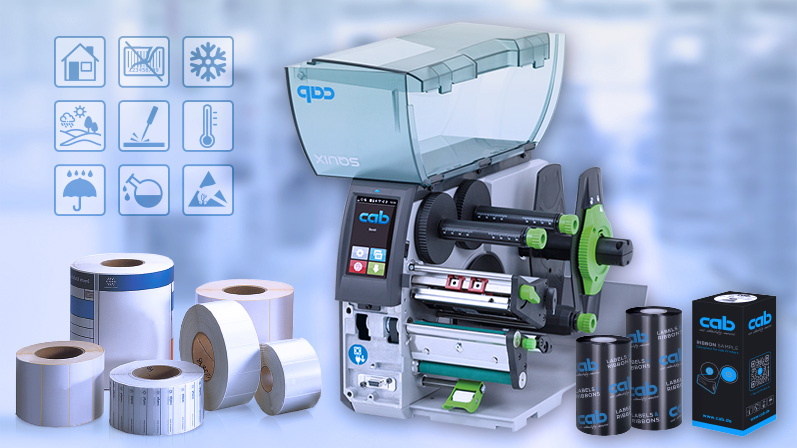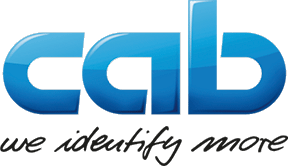Eyes open when buying a printer
Why thermal transfer is a winner


- Kristian Jakovcic
cab Development Division
An editorial cab interview with Kristian Jakovcic, developer
We at cab develop and manufacture thermal transfer printers. On these, a special film is heated by the print head on selected spots. Color melts into the material to be printed. What benefits this method for printing labels? What other features are to expect from a label printer? Our expert provides information.
Kristian, what are basics to observe when printing labels?
Jakovcic: Let me put it this way: Each print operation is individual. So are its requirements. Print volumes and widths matter, so do label sizes and print image quality. When printed labels are to be applied automatically to objects, cycle rates are an issue, whether objects are at rest or in motion and from which direction labels are applied. Depending on the use, resistances are required to blurring and scratching, direct sunlight and temperatures extremely high or low. Rugged work environments mean humidity, chemicals, dusts or oils.
What about directives implied by industry, or State order?
Jakovcic: Labeling is regulated, whether on food, electronics, chemicals or pharmaceuticals, whether these are solid, liquids or powders.
Which print method benefits for labels, and why?
Jakovcic: This can hardly be said in general terms. Each operation is individual. Digital printing is particularly effective with small label volumes printed multi-colored in different designs. Thermal transfer printing is first choice if variable data is to be added to preprinted multicolor labels. This method is particularly economical with large label volumes. There is no waiting for colors to dry, as is the case with inkjet. Proper materials provided, thermal labeling remains legible on goods during processing, inspection, picking, stock and transport. Other print methods are much more sensitive.
What are you thinking about in particular?
Jakovcic: Inkjet printing based on other than pigmented ink will probably result in print images smearing in cases of contact, or when exposed to water or solvents. Laser printing does not smear. However, the intense heat of such units does not comply with label adhesives.
Users see cost-effective operations a major concern.
Jakovcic: Absolutely! With our printers processing label rolls, using thermal transfer method, users remain flexible even with large label volumes, as well as individual ones. There is no need of label sheets be reload over and over again. Waste is reduced.
Industrial businesses demand industrious machines. Please give us some figures on labeling.
Jakovcic: Our printers are running with maximum print speeds of 300 mm/s. Several thousand labels per day can be labeled in high quality in continuous operation. Print resolutions up to 600 dpi, high contrast and print images razor-sharp in all areas are required to verify small batch numbers with the eye and micro codes with scanners. cab printers can do this. They are also particularly flexible. On MACH 4S devices, for example, retainers equipped with labels of different widths can be exchanged as required. The cover opens to the top. By this, no additional space is needed laterally in cases of maintenance or change of materials. EOS printers can be supplied with rechargeable batteries. Mobile printing is enabled when no power sockets are available.
What further processes benefit from thermal transfer printing?
Jakovcic: Many customers have to add variable data on preprinted or decorative labels. Industrial businesses, in particular, opt for labels be further processed after printing. In the industrial label printers range, we at present provide the most extensive range of accessories on the market. Label rolls can be rewound or unwound, labels be applied to objects after printing. Printed labels can also be separated and collected in a tray, or perforated, to be easily separated by hand later. Linear 1D, 2D or stacked codes can be verified on validity and readability.
We go even deeper when it comes to applying printed labels to objects.
Jakovcic: That‘s right. We provide a wide range of applicators to add to SQUIX print units, even more HERMES. In cases of operations changing, exchange is easy. Whether labels are to be automatically pressed, rolled or blown on objects, corner-wrap, in motion or at rest – we offer solutions for any operation. This is unique on the market. Thanks to standardization, the modular concept is global.
Which further processes do not comply with thermal transfer, and why?
Jakovcic: Label finishings, such as spot coating, hot-film embossing or blind stamping, are not common in thermal transfer printing.
How have label printers developed in recent years? What about innovations and their impact?
Jakovcic: It was not that long ago that Industry 4.0 and the Internet of Things described visionary technological perspectives. Smart processes are now practice in all bearing industrial sectors. By integrating label printers smoothly to such information systems, label data can be identified, assigned, documented and transmitted specific to manufacture or users, for example using radio signals. I cannot judge all printer models on the market. But I can certainly confirm all our current label printing systems ready for this interaction.
Which features help embedding such systems to digitized workflows?
Jakovcic: The devices must provide proper interfaces. This is the case on all our current printers. In addition, an OPC UA server and an OPC UA client are a part of the firmware. The server enables the printer be configured and controlled. Dynamic print data can be edited using a defined programming interface. The client enables reading data fields from other machines ready for OPC UA, or transfer data to a label. Then there is the WebDAV transfer protocol. It enables virtual memories integrate to cab devices via a network. The Web memory becomes available as a drive. It can thus be accessed locally from anywhere.
On this topic:
Industries: Electronics | Laboratory | Hazardous goods | Textile
February 2022

